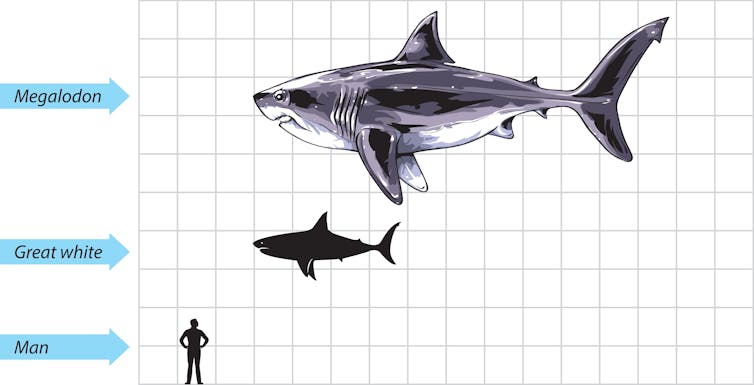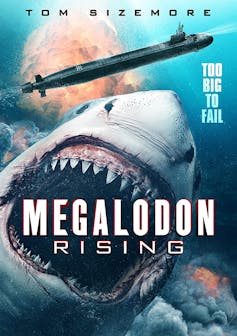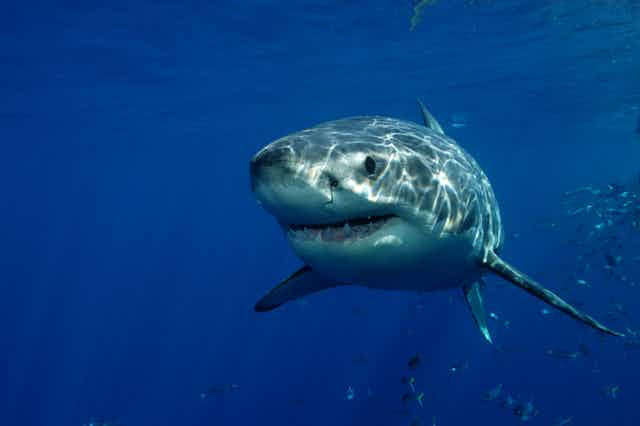When my children ask me, “What’s your favourite dinosaur?” I always respond, “A megalodon.” This is much to their disgust, as they expect the stock answer of Rexy or Dippy. But as a shark enthusiast, I may need to change my answer and say great whites (and their ancestors) after scientists have showed the two species coexisted and competed – and it would appear the great whites won.
I wasn’t being entirely honest with my kids, who rightly point out that megalodon existed some time after the last dinosaurs died out (excluding birds). But it was nonetheless a true beast, the largest predator ever to inhabit our oceans, growing to a phenomenal size of 18 metres and weighing in at over 50 tonnes. For comparison, a great white can grow up to 6 metres but weighs less than 2 tonnes.

Until recently, scientists largely believed that great white sharks were smaller, faster versions of megalodons. But in recent years, new evidence has moved us away from thinking they were members of the same family, and its genus is still debated among marine biologists.
Now the latest research suggests the two species existed at the same time and were in competition with one another. The new study, published in the journal Nature Communications, has raised the question whether the great white was among the potential causes of the megalodon’s extinction.
Only the teeth remain
Until recently, the abrupt disappearance in the fossil record of the megalodon 2.5 million years ago remained a mystery. To investigate what happened, the researchers behind the new study decided to look at the diet of great white sharks, their ancestors and megalodon.
One of the problems with researching sharks is that their skeletons are mostly made of cartilage, so after decomposition almost all that remains are teeth. Learning about these animals from fossil evidence therefore requires a best-guest approach based on species that roam the earth today. What we know about megalodon is based almost entirely on their teeth (megalodon even means “big tooth”) and scientists have to make educated guesses about the rest of their bodies.

So how do you investigate the diet of a long-gone animal, when only its teeth have survived? To solve this problem, scientists looked for concentrations of zinc isotopes in the fossilised teeth of megalodon and in teeth of past and present great whites.
Isotopes are variants of an element that act as a sort of chemical signature. In this case, different zinc isotopes can indicate what sort of diet a fossilised animal had and where it sat in the food chain.
The presence of the same levels of different zinc isotopes suggested that great white ancestors and megalodons once ate the same food and occupied the same position in the food web. There then appears to have been a shift as the great whites – the newcomers, the underdogs – relegated megalodon and took over.
Changing climate, changing sharks
How could the demise of the largest ever apex predator have coincided with the rise of one of today’s apex predators? One theory that aligns with the analysis in the latest research is that a changing climate is responsible. During the dominance of megalodon, the climate was milder and the seas were generally warmer, enabling the large predator to patrol all over both the northern and southern hemispheres.
The rise of great white sharks coincided with with changing sea conditions and general cooling at both poles. Cooler waters meant krill boomed in coastal areas, as did the baleen whales that fed on them. As megalodon was only able to survive in warmer waters, the more adaptable great whites were able to exploit the absence of a key competitor and feast on the growing whale populations.

Colleagues and I research the environmental factors affecting great white sharks in Mossel Bay, South Africa, and it is fairly well known that the present-day species exist in water temperatures ranging from 12°C to 24°C. At the lower end, this would have been too cold for the megalodon. It appears that, as whales and other marine mammals adapted to cooler climes a few million years ago, great whites followed them into these waters and were able to sit at the top of the food chain. The megalodons would have had to settle for smaller fish in warmer waters, with less of the high-energy fatty blubber they needed.
Great white sharks appear to have benefited from the “survival of the fittest”. People often confuse this Darwinian phrase as meaning the strongest and biggest survive. But it really revolves around which species is best adapted to survive the changes in the environment and come out the other side alive, able to carry on the lineage and reproductive success of the species.

